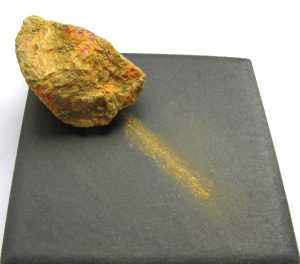
The modern student of eighteenth-century color would be forgiven for thinking that Dutch pink would be a species of red. This is not the case; Dutch pink is yellow. The color “pink” wasn’t recognized as its own category until it was given the name of the flower which best embodied it; this was the dianthus, historically called a “pynk,” and though it comes in many colors, it is a relief to find that the most common varieties are light red. In the early modern sense, however, “pink” instead named any pigment created by precipitating an organic dye on a mineral or metallic salt, like chalk. Without a color-adjective, it named varieties of yellow, as in French, English, and Dutch pink; with an adjective, pinks included a wide range of pigments, including whites, muddy greens, and browns, and, by coincidence, a few reds.

Pinks were cheap. They repurposed bulk colorants already used widely in the textile industry, and could be harvested by growers who specialized in those reagents; many of those crops, like madder or indigo, had been grown for millennia, and benefitted both from selective breeding and a long history of traditional knowledge about how they were to be cultivated. What is more, dyers had already worked out how to attach a rich range of such organic reagents to animal and vegetable fibers directly, using a process called “mordanting”; mordants are metallic salts, like alum, which act as little “ionic bridges” between the organic compounds of dyes and the different organic compounds of textile fibers. The trick among the painter-stainers was only to fix those same dyes to something else that could be put in a more pliable medium, like linseed oil, water, or ethanol.

But nature’s green is gold, says the poet; it is the hardest hue to hold. Pinks are what are known as fugitive colors: fugitive, because they fly. They fade in sunlight, like the fabric dyes they’re made from, and also with contact with other chemicals and sometimes just with age. In fact, one of the reasons I’m having to recover all these paints from historical recipes, making them myself, is that they weren’t much used by the best painters in the fine arts. Consequently, there is not much demand for them in conservation work, or among modern painters interested in the best historical pigments. The expensive, colorfast pigments you can still get. You can go out and buy massicot, a mineral yellow which is almost perfectly colorfast, or orpiment, a malodorous and incidentally toxic compound of sulfur and arsenic which gives a brilliant gold. But if you want a disreputable color, a color like Dutch pink, you’ll have to source the berries and make it yourself. (I include a recipe at the end.)

Yellow pinks could be made from a wide range of dyes already in use. Saffron was prohibitively expensive, but weld, sometimes called “dyer’s weed,” was cheap and widely cultivated, and old fustic, a western-hemisphere plant, was already making inroads as a yet cheaper alternative for inexpensive textiles. But the reagents recommended for the best pinks were two botanicals each differently imported from the Levant. The first are a family of berries from plants of the genus Rhamnus, a berry-bearing shrub commonly called the buckthorn; this was cultivated in southern Europe as a dyer’s resource, and went commonly by the names “Avignon berry,” “French berry,” or “Persian berry.” These sometimes appear to name berries from different species of the buckthorn, and sometimes not. The other, turmeric, a root cultivated in interior Asia and the Asiatic subcontinent, arrived to Europe through places like Damascus and Aleppo. As the histories of each of these reagents attest, the same trade routes that carried Europe’s pharmicon also carried its dyestuffs; Rhamnus berries and Rhamnus bark are purgatives, and turmeric has been used for a range of ailments, including as an anti-inflammatory.
Together, the unripe berries of the buckthorn and the root of turmeric produce a brilliant, if not-quite colorfast yellow. This is Dutch pink, which is among the simplest of all eighteenth-century pigments to make. Here is a recipe, from Robert Dossie’s Handmaid of Arts (1758):

There are a variety of methods of preparing Dutch pink : but the following is very cheap and easy ; and makes a most beautiful pigment.
“ Take of French berries one pound, and
“ of turmeric root powdered four ounces ; boil
“ them in a gallon of water two hours ; and
“ then strain off the tincture through flannel,
“ and boil it again with an ounce of alum till
“ it be evaporated to one quart. Prepare in
“ the mean time four pounds of chalk, by
“ washing it over, and afterwards drying it :
“ and mix the chalk with the tincture, by
“ grinding them together: and then lay out the
“ Dutch pink thus made to dry on boards.”
The goodness of Dutch pink consists in its being of a full gold coloured yellow, and very bright.
Of English pink.
English pink is only a lighter and coarser kind of Dutch pink.